Filed Pursuant to Rule 424(b)(3)
Registration No. 333-275353
Prospectus Supplement No. 1
(to Prospectus dated
December 22, 2023)

Up to 1,714,570 Shares of Common Stock
This prospectus supplement supplements the prospectus, dated December 22, 2023, or the Prospectus, which forms a part of our registration
statement on Form S-1 (No. 333-275353). This prospectus supplement is being filed to update and supplement the information in the Prospectus with the information
contained in our Current Report on Form 8-K filed with the Securities and Exchange Commission on January 9, 2024, or the Current Report. Accordingly, we have attached the Current Report to this prospectus
supplement.
The Prospectus and this prospectus supplement relate to the proposed offer and resale or other disposition from time to time
by the selling stockholders identified in this prospectus of up to an aggregate of 1,714,570 shares of common stock, par value $0.001 per share, of Korro Bio, Inc.
We are registering the resale of the shares of common stock pursuant to the selling stockholders’ registration rights under a
registration rights agreement between us and the selling stockholders. Our registration of the resale of the shares of common stock covered by this prospectus does not mean that the selling stockholders will offer or sell all or any of the shares of
common stock. The selling stockholders may offer, sell or distribute all or a portion of their shares of common stock from time to time directly or indirectly through one or more underwriters, broker-dealers or agents, and in one or more public or
private transactions. The shares of common stock may be sold in one or more transactions at fixed prices, at prevailing market prices at the time of the sale, at varying prices determined at the time of sale or at negotiated prices. These sales may
be effected in transactions, which may involve crosses or block transactions. See the section entitled “Plan of Distribution” for more information.
We will not receive any proceeds from any sale of common stock by the selling stockholders pursuant to this prospectus. We have agreed to bear
the expenses in connection with the registration of the resale of the shares of common stock to be offered by this prospectus by the selling stockholders other than any underwriting discounts and commissions or transfer taxes relating to the sale of
common stock, which will be borne by the selling stockholders.
We are an “emerging growth company” as defined under the federal
securities laws and, as such, have elected to comply with certain reduced public company reporting requirements for this prospectus and our other filings with the Securities and Exchange Commission.
Our common stock is listed on the Nasdaq Capital Market, or Nasdaq, under the symbol “KRRO.” On January 5, 2024, the closing
price for our common stock, as reported on Nasdaq, was $50.49 per share.
See the
section entitled “Risk Factors” beginning on page 5 of this prospectus to read about factors you should consider before buying our securities.
Neither the Securities and Exchange Commission nor any state securities commission has approved or disapproved of these securities or
determined if this prospectus is truthful or complete. Any representation to the contrary is a criminal offense.
The date of this
prospectus supplement is January 9, 2024
UNITED STATES
SECURITIES
AND EXCHANGE COMMISSION
Washington, D.C. 20549
FORM 8-K
CURRENT REPORT
Pursuant
to Section 13 OR 15(d) of The Securities Exchange Act of 1934
Date of Report (Date of earliest event reported):
January 9, 2024
Korro Bio, Inc.
(Exact
name of registrant as specified in its charter)
|
|
|
|
|
| Delaware |
|
001-39062 |
|
47-2324450 |
(State or other jurisdiction
of incorporation) |
|
(Commission
File Number) |
|
(IRS Employer
Identification
No.) |
|
|
|
| One Kendall Square, Building 600-700, Suite 6-401, Cambridge, MA |
|
02139 |
| (Address of principal executive offices) |
|
(Zip Code) |
Registrant’s telephone number, including area code: (617)
468-1999
Check the appropriate box below if the Form 8-K filing is intended to simultaneously satisfy the filing obligation of
the registrant under any of the following provisions:
☐ Written communications pursuant to Rule 425 under the Securities Act (17 CFR 230.425)
☐ Soliciting material pursuant to Rule 14a-12 under the Exchange Act (17 CFR
240.14a-12)
☐ Pre-commencement communications pursuant to Rule 14d-2(b) under the Exchange Act (17 CFR 240.14d-2(b))
☐ Pre-commencement communications pursuant to Rule 13e-4(c) under the Exchange Act (17 CFR 240.13e-4(c))
Securities registered pursuant to Section 12(b) of the Act:
|
|
|
|
|
| Title of each class |
|
Trading
Symbol(s) |
|
Name of each exchange on which registered |
| Common stock, par value $0.001 per share |
|
KRRO |
|
The Nasdaq Capital Market |
Indicate by check mark whether the registrant is an emerging growth company as defined in Rule 405 of the Securities Act of
1933 (§230.405 of this chapter) or Rule 12b-2 of the Securities Exchange Act of 1934 (§240.12b-2 of this chapter).
Emerging growth company ☒
If an emerging
growth company, indicate by check mark if the registrant has elected not to use the extended transition period for complying with any new or revised financial accounting standards provided pursuant to Section 13(a) of the Exchange Act. ☐
On January 9, 2024, Korro Bio, Inc. updated its corporate presentation for use in meetings with investors, analysts and others. A copy of the corporate
presentation is filed as Exhibit 99.1 to this Current Report on Form 8-K and is incorporated by reference into this Item 8.01.
| Item 9.01. |
Financial Statements and Exhibits. |
(d) Exhibits
|
|
|
Exhibit
No. |
|
Description |
|
|
| 99.1 |
|
Corporate Presentation of Korro Bio, Inc., dated January 9, 2024. |
|
|
| 104 |
|
Cover Page Interactive Data File (embedded within the Inline XBRL document). |
SIGNATURES
Pursuant to the requirements of the Securities Exchange Act of 1934, the registrant has duly caused this report to be signed on its behalf by
the undersigned hereunto duly authorized.
|
|
|
|
|
|
|
|
|
|
|
KORRO BIO, INC. |
|
|
|
|
| Date: January 9, 2024 |
|
|
|
By: |
|
/s/ Ram Aiyar |
|
|
|
|
Name: |
|
Ram Aiyar |
|
|
|
|
Title: |
|
President and Chief Executive Officer |
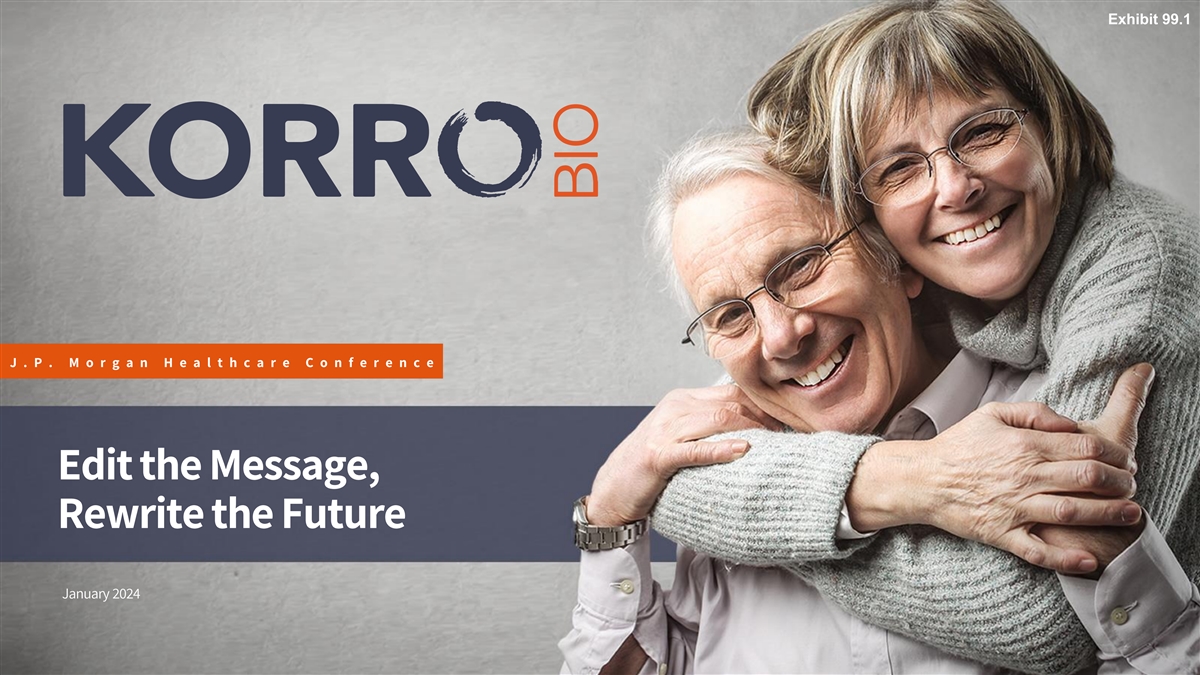
Exhibit 99.1 J . P . M o r g a n H e a l t h c a r e C o n f e r e n c e
Edit the Message, Rewrite the Future January 2024 1
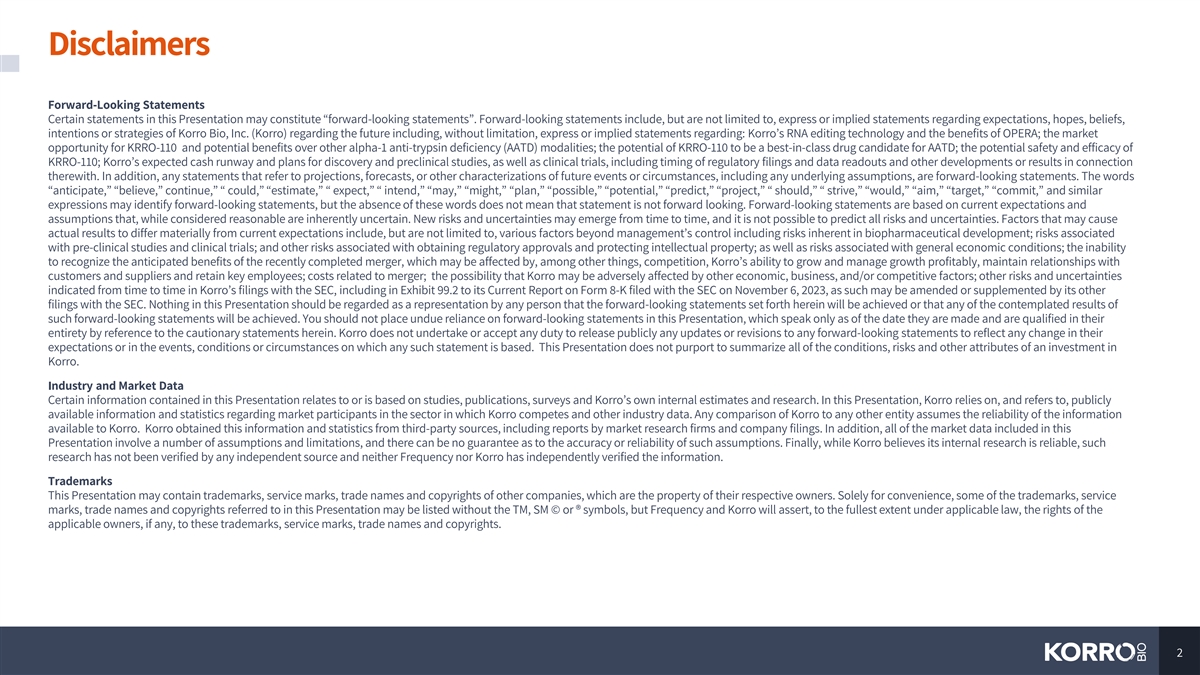
Disclaimers Forward-Looking Statements Certain statements in this
Presentation may constitute “forward-looking statements”. Forward-looking statements include, but are not limited to, express or implied statements regarding expectations, hopes, beliefs, intentions or strategies of Korro Bio, Inc.
(Korro) regarding the future including, without limitation, express or implied statements regarding: Korro’s RNA editing technology and the benefits of OPERA; the market opportunity for KRRO-110 and potential benefits over other alpha-1
anti-trypsin deficiency (AATD) modalities; the potential of KRRO-110 to be a best-in-class drug candidate for AATD; the potential safety and efficacy of KRRO-110; Korro’s expected cash runway and plans for discovery and preclinical studies, as
well as clinical trials, including timing of regulatory filings and data readouts and other developments or results in connection therewith. In addition, any statements that refer to projections, forecasts, or other characterizations of future
events or circumstances, including any underlying assumptions, are forward-looking statements. The words “anticipate,” “believe,” continue,” “ could,” “estimate,” “ expect,” “
intend,” “may,” “might,” “plan,” “possible,” “potential,” “predict,” “project,” “ should,” “ strive,” “would,”
“aim,” “target,” “commit,” and similar expressions may identify forward-looking statements, but the absence of these words does not mean that statement is not forward looking. Forward-looking statements are based
on current expectations and assumptions that, while considered reasonable are inherently uncertain. New risks and uncertainties may emerge from time to time, and it is not possible to predict all risks and uncertainties. Factors that may cause
actual results to differ materially from current expectations include, but are not limited to, various factors beyond management’s control including risks inherent in biopharmaceutical development; risks associated with pre-clinical studies
and clinical trials; and other risks associated with obtaining regulatory approvals and protecting intellectual property; as well as risks associated with general economic conditions; the inability to recognize the anticipated benefits of the
recently completed merger, which may be affected by, among other things, competition, Korro’s ability to grow and manage growth profitably, maintain relationships with customers and suppliers and retain key employees; costs related to merger;
the possibility that Korro may be adversely affected by other economic, business, and/or competitive factors; other risks and uncertainties indicated from time to time in Korro’s filings with the SEC, including in Exhibit 99.2 to its Current
Report on Form 8-K filed with the SEC on November 6, 2023, as such may be amended or supplemented by its other filings with the SEC. Nothing in this Presentation should be regarded as a representation by any person that the forward-looking
statements set forth herein will be achieved or that any of the contemplated results of such forward-looking statements will be achieved. You should not place undue reliance on forward-looking statements in this Presentation, which speak only as of
the date they are made and are qualified in their entirety by reference to the cautionary statements herein. Korro does not undertake or accept any duty to release publicly any updates or revisions to any forward-looking statements to reflect any
change in their expectations or in the events, conditions or circumstances on which any such statement is based. This Presentation does not purport to summarize all of the conditions, risks and other attributes of an investment in Korro. Industry
and Market Data Certain information contained in this Presentation relates to or is based on studies, publications, surveys and Korro’s own internal estimates and research. In this Presentation, Korro relies on, and refers to, publicly
available information and statistics regarding market participants in the sector in which Korro competes and other industry data. Any comparison of Korro to any other entity assumes the reliability of the information available to Korro. Korro
obtained this information and statistics from third-party sources, including reports by market research firms and company filings. In addition, all of the market data included in this Presentation involve a number of assumptions and limitations, and
there can be no guarantee as to the accuracy or reliability of such assumptions. Finally, while Korro believes its internal research is reliable, such research has not been verified by any independent source and neither Frequency nor Korro has
independently verified the information. Trademarks This Presentation may contain trademarks, service marks, trade names and copyrights of other companies, which are the property of their respective owners. Solely for convenience, some of the
trademarks, service marks, trade names and copyrights referred to in this Presentation may be listed without the TM, SM © or ® symbols, but Frequency and Korro will assert, to the fullest extent under applicable law, the rights of the
applicable owners, if any, to these trademarks, service marks, trade names and copyrights. 2
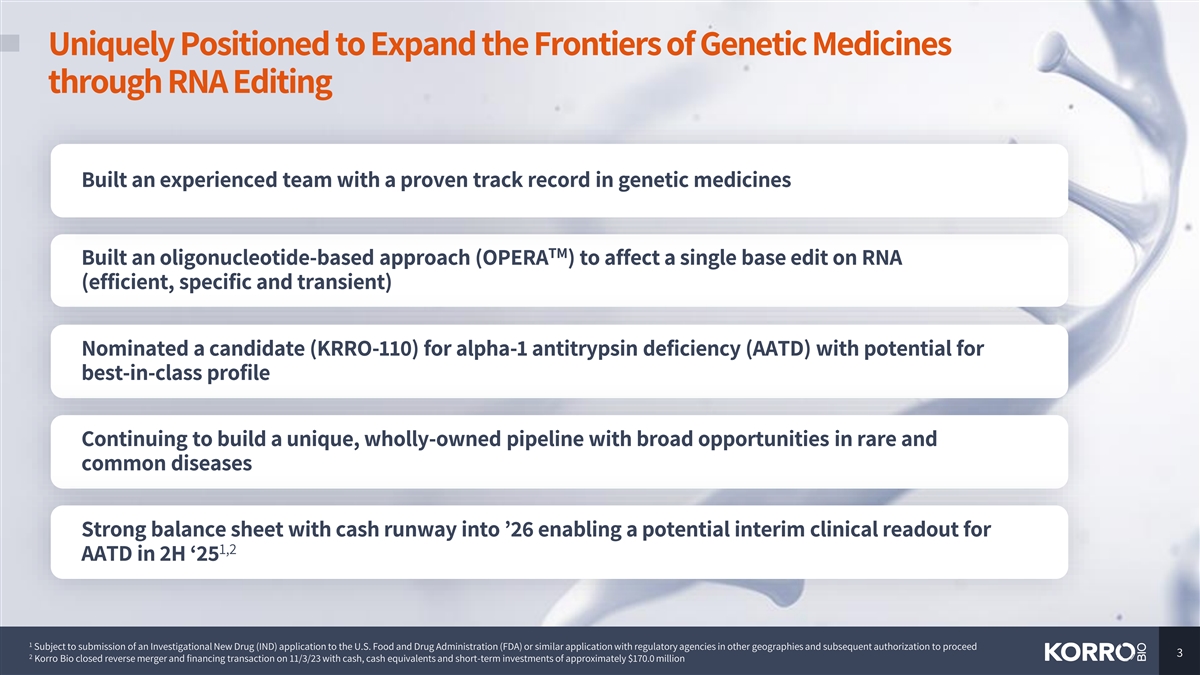
Uniquely Positioned to Expand the Frontiers of Genetic Medicines through
RNA Editing Built an experienced team with a proven track record in genetic medicines TM Built an oligonucleotide-based approach (OPERA ) to affect a single base edit on RNA (efficient, specific and transient) Nominated a candidate (KRRO-110) for
alpha-1 antitrypsin deficiency (AATD) with potential for best-in-class profile Continuing to build a unique, wholly-owned pipeline with broad opportunities in rare and common diseases Strong balance sheet with cash runway into ’26 enabling a
potential interim clinical readout for 1,2 AATD in 2H ‘25 1 Subject to submission of an Investigational New Drug (IND) application to the U.S. Food and Drug Administration (FDA) or similar application with regulatory agencies in other
geographies and subsequent authorization to proceed 3 2 Korro Bio closed reverse merger and financing transaction on 11/3/23 with cash, cash equivalents and short-term investments of approximately $170.0 million
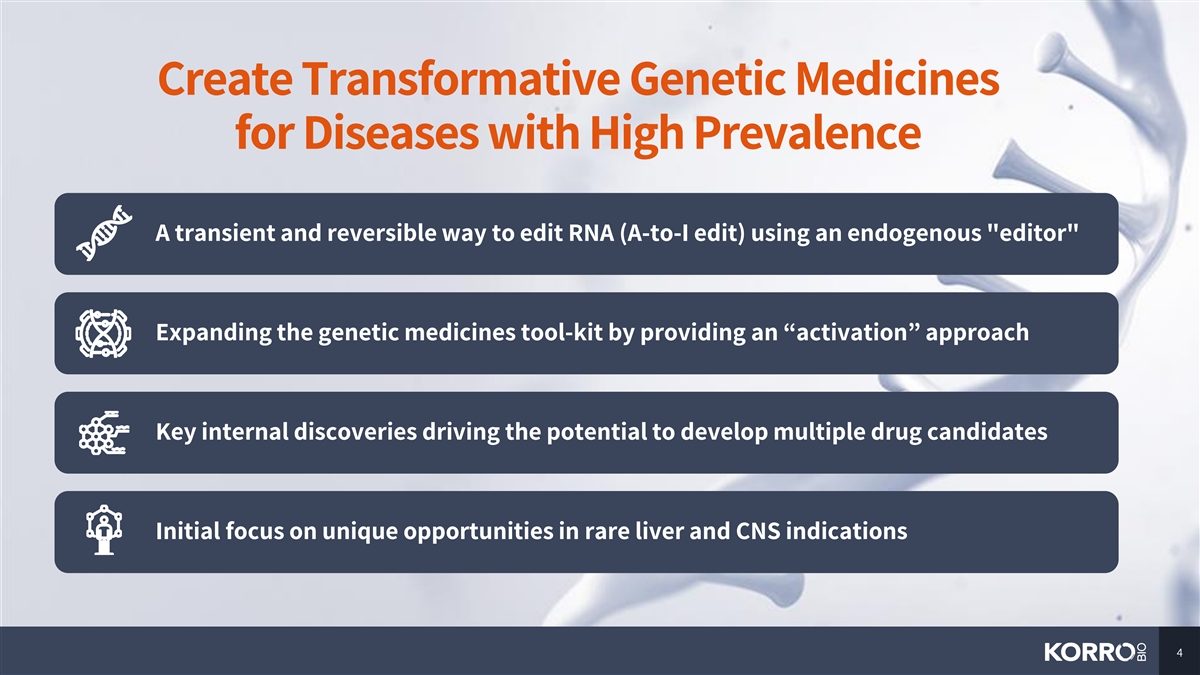
Create Transformative Genetic Medicines for Diseases with High
Prevalence A transient and reversible way to edit RNA (A-to-I edit) using an endogenous editor Expanding the genetic medicines tool-kit by providing an “activation” approach Key internal discoveries driving the potential to develop
multiple drug candidates Initial focus on unique opportunities in rare liver and CNS indications 4
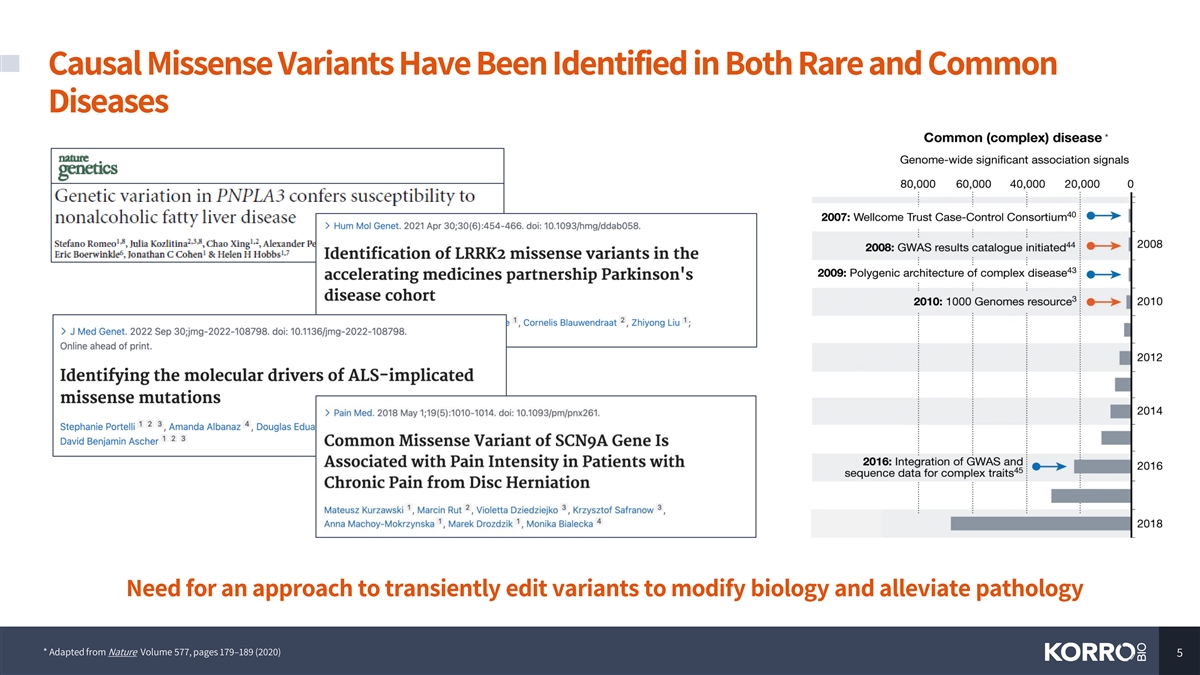
Causal Missense Variants Have Been Identified in Both Rare and Common
Diseases * Need for an approach to transiently edit variants to modify biology and alleviate pathology * Adapted from Nature Volume 577, pages 179–189 (2020) 5
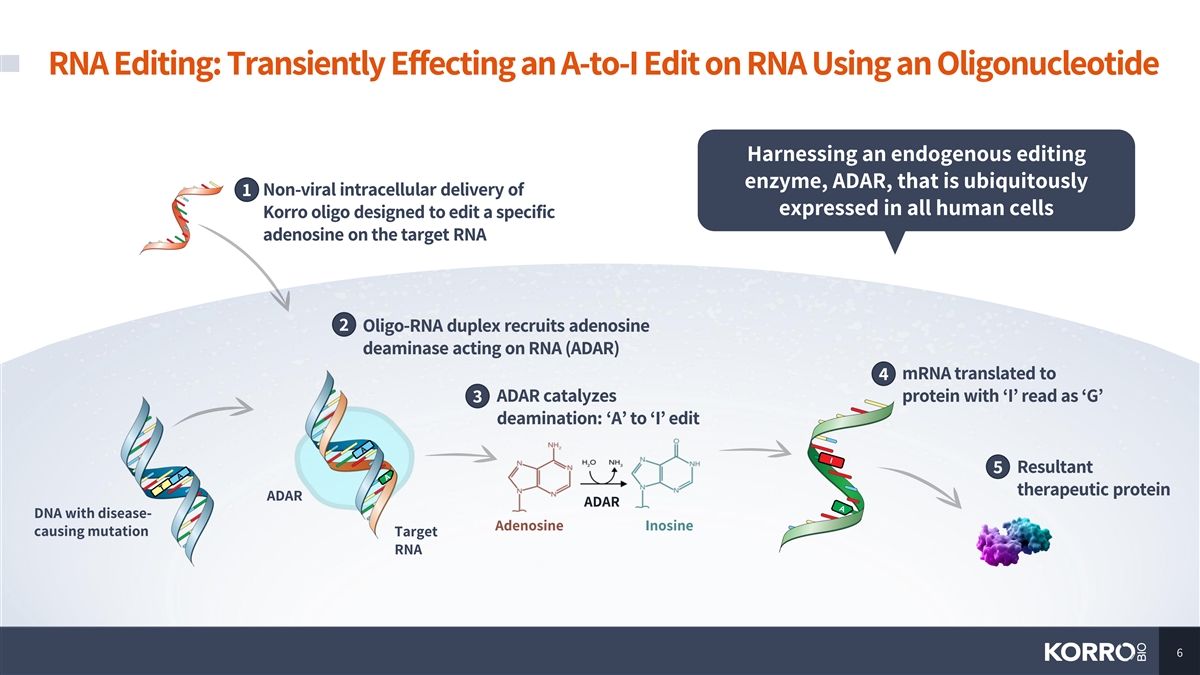
RNA Editing: Transiently Effecting an A-to-I Edit on RNA Using an
Oligonucleotide Harnessing an endogenous editing enzyme, ADAR, that is ubiquitously 1 Non-viral intracellular delivery of expressed in all human cells Korro oligo designed to edit a specific adenosine on the target RNA 2 Oligo-RNA duplex recruits
adenosine deaminase acting on RNA (ADAR) 4 mRNA translated to 3 ADAR catalyzes protein with ‘I’ read as ‘G’ deamination: ‘A’ to ‘I’ edit Resultant 5 therapeutic protein ADAR ADAR DNA with disease-
Adenosine Inosine causing mutation Target RNA 6
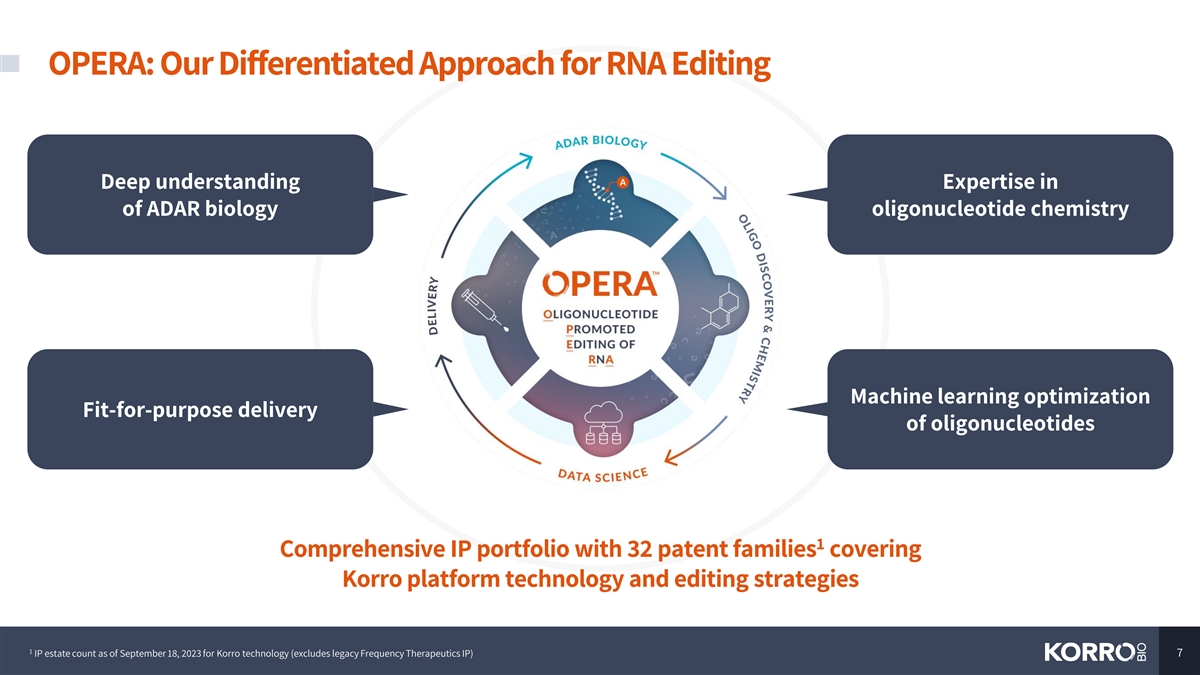
OPERA: Our Differentiated Approach for RNA Editing Deep understanding
Expertise in of ADAR biology oligonucleotide chemistry Machine learning optimization Fit-for-purpose delivery of oligonucleotides 1 Comprehensive IP portfolio with 32 patent families covering Korro platform technology and editing strategies 1 IP
estate count as of September 18, 2023 for Korro technology (excludes legacy Frequency Therapeutics IP) 7
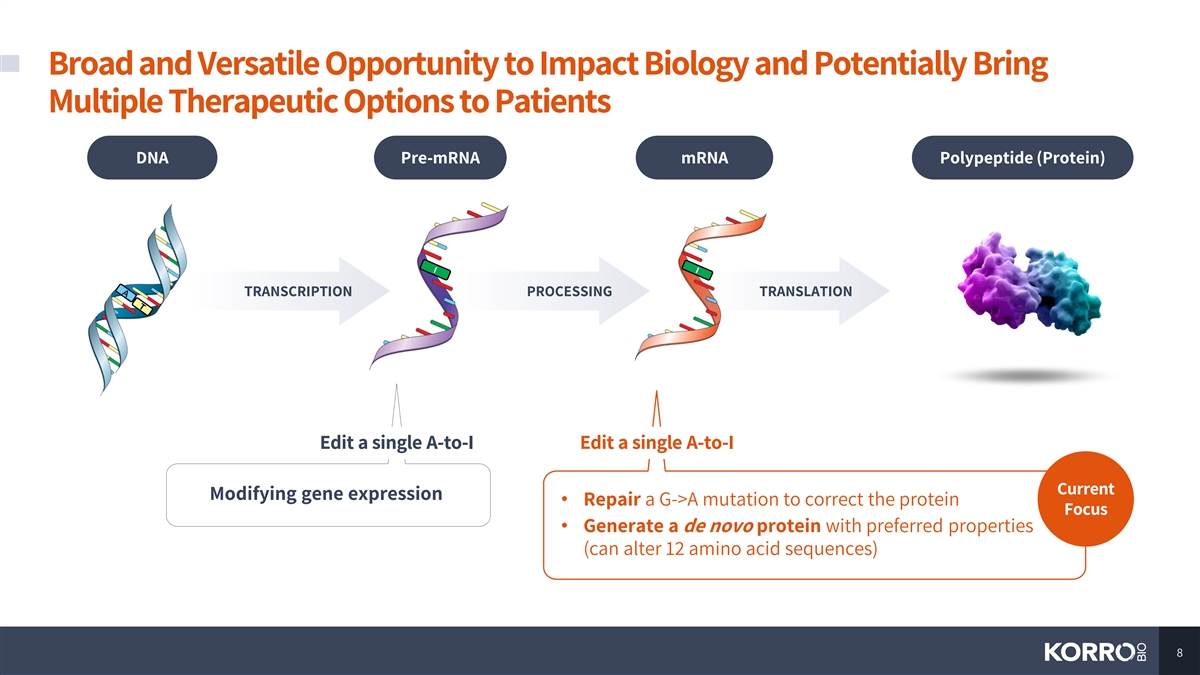
Broad and Versatile Opportunity to Impact Biology and Potentially Bring
Multiple Therapeutic Options to Patients DNA Pre-mRNA mRNA Polypeptide (Protein) TRANSCRIPTION PROCESSING TRANSLATION Edit a single A-to-I Edit a single A-to-I Current Modifying gene expression • Repair a G->A mutation to correct the
protein Focus • Generate a de novo protein with preferred properties (can alter 12 amino acid sequences) 8
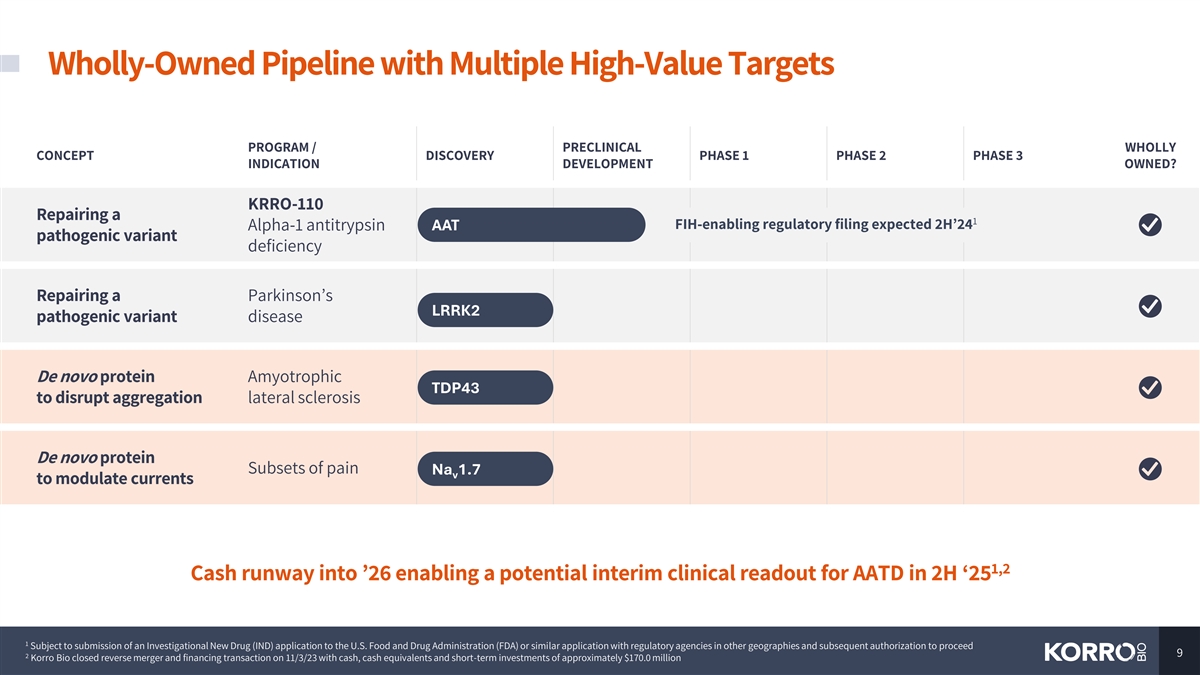
Wholly-Owned Pipeline with Multiple High-Value Targets PROGRAM /
PRECLINICAL WHOLLY CONCEPT DISCOVERY PHASE 1 PHASE 2 PHASE 3 INDICATION DEVELOPMENT OWNED? KRRO-110 Repairing a 1 FIH-enabling regulatory filing expected 2H’24 AAT Alpha-1 antitrypsin pathogenic variant deficiency Repairing a Parkinson’s
LRRK2 pathogenic variant disease De novo protein Amyotrophic TDP43 to disrupt aggregation lateral sclerosis De novo protein Subsets of pain Na 1.7 v to modulate currents 1,2 Cash runway into ’26 enabling a potential interim clinical readout
for AATD in 2H ‘25 1 Subject to submission of an Investigational New Drug (IND) application to the U.S. Food and Drug Administration (FDA) or similar application with regulatory agencies in other geographies and subsequent authorization to
proceed 9 2 Korro Bio closed reverse merger and financing transaction on 11/3/23 with cash, cash equivalents and short-term investments of approximately $170.0 million
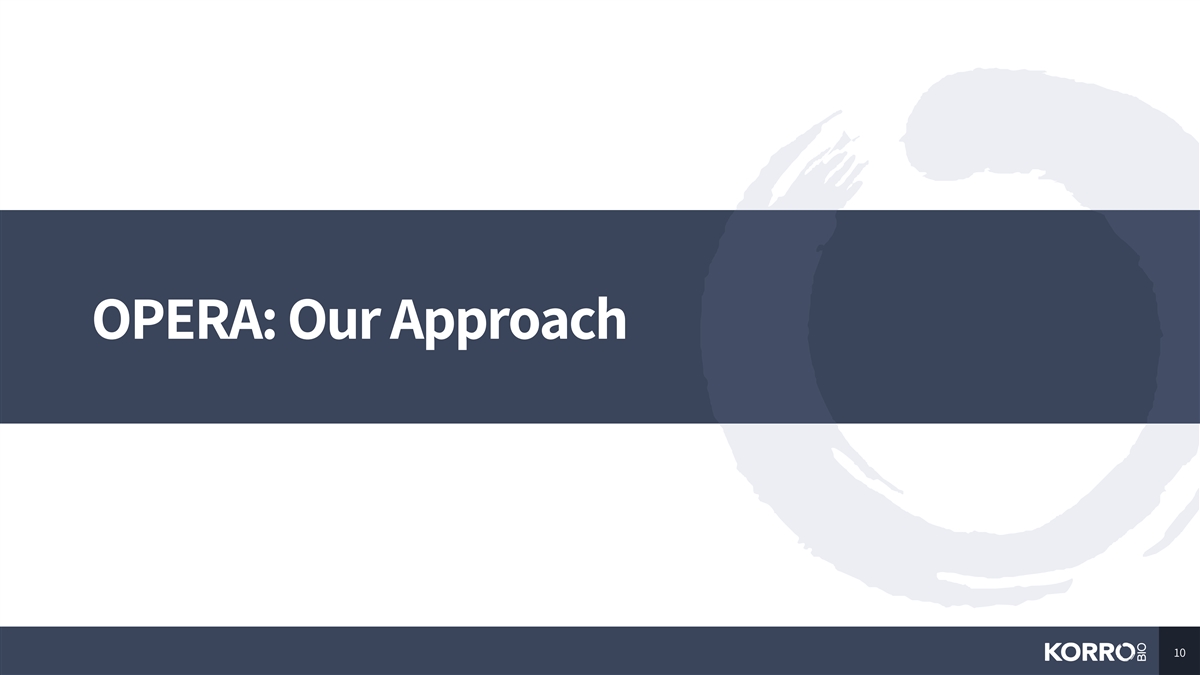
OPERA: Our Approach 10
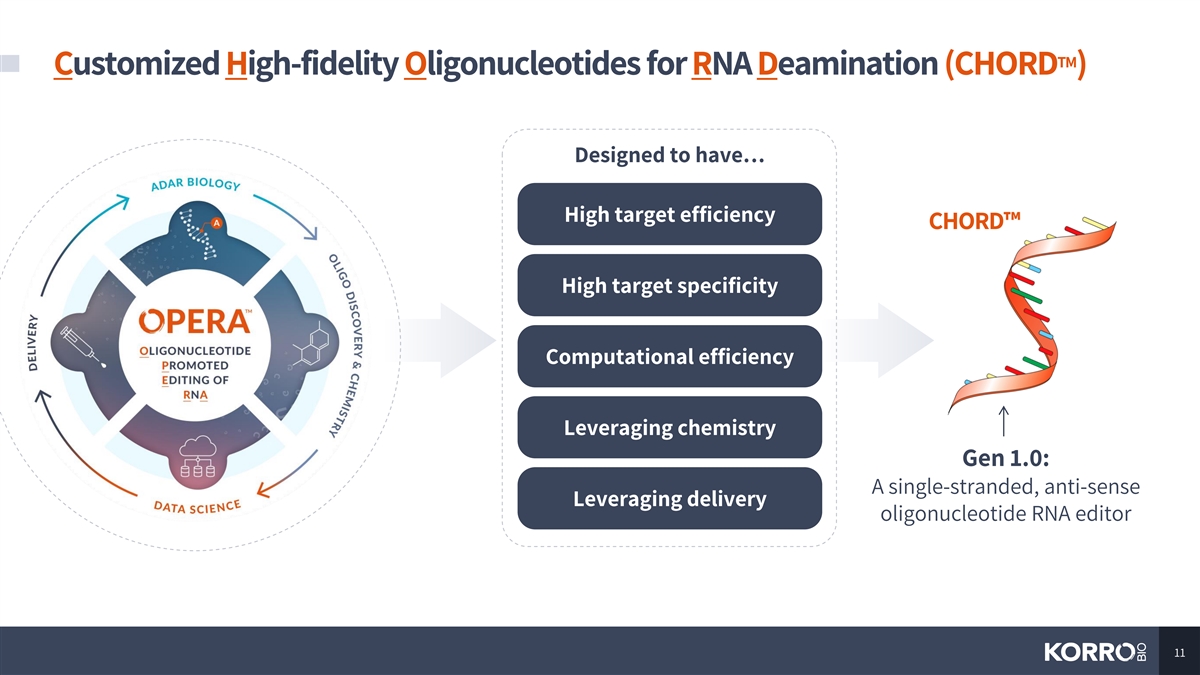
TM Customized High-fidelity Oligonucleotides for RNA Deamination (CHORD
) Designed to have… High target efficiency CHORD High target specificity Computational efficiency Leveraging chemistry Gen 1.0: A single-stranded, anti-sense Leveraging delivery oligonucleotide RNA editor 11

High Efficiency: Ability to Potentially Target Any “A” of
Interest on Any Transcript 1 Primary Mouse Hepatocytes Patient-derived Neuroblastoma Cells >45% editing achieved >80% editing achieved 100 100 80 80 60 60 40 40 20 20 0 0 SERPINA1 RAB7A UGP2 ACTB UGP2 ACTB RAB7A TDP43 1 SERPINA1 data is from
PiZ primary mouse hepatocytes and ACTB, RAB7, and UGP2 data is from wild-type primary mouse hepatocytes (PMH) 12 Editing (%) Editing (%)
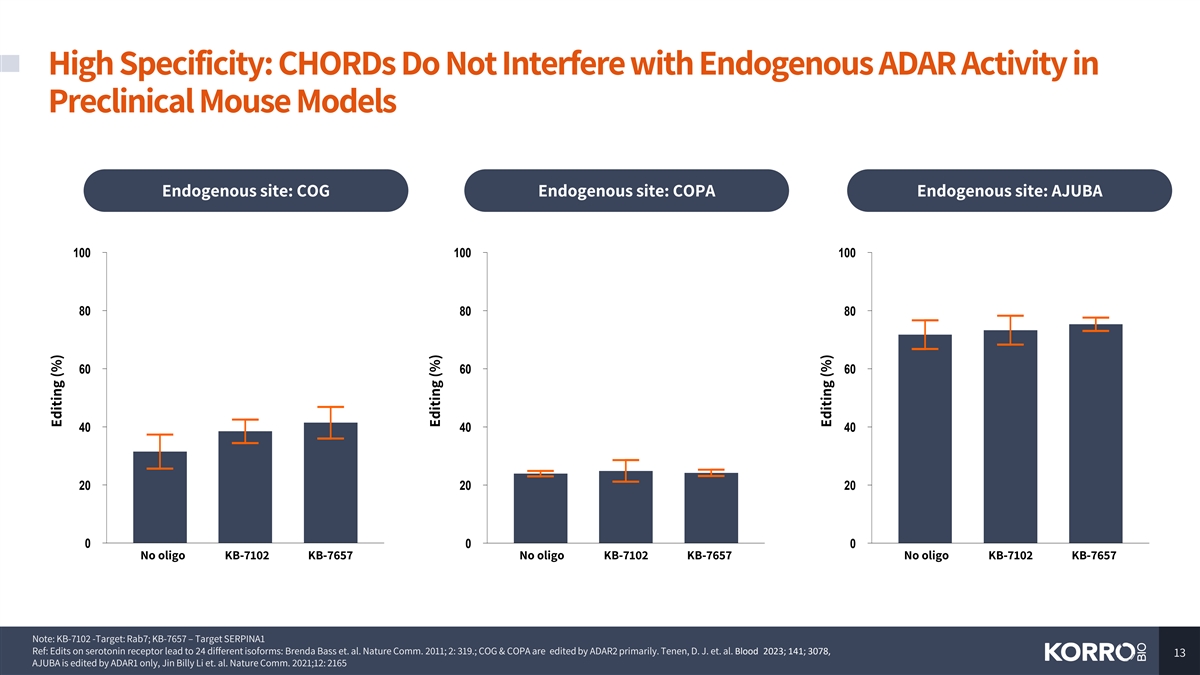
High Specificity: CHORDs Do Not Interfere with Endogenous ADAR Activity
in Preclinical Mouse Models Endogenous site: COG Endogenous site: COPA Endogenous site: AJUBA 100 100 100 80 80 80 60 60 60 40 40 40 20 20 20 0 0 0 No oligo KB-7102 KB-7657 No oligo KB-7102 KB-7657 No oligo KB-7102 KB-7657 Note: KB-7102 -Target:
Rab7; KB-7657 – Target SERPINA1 Ref: Edits on serotonin receptor lead to 24 different isoforms: Brenda Bass et. al. Nature Comm. 2011; 2: 319.; COG & COPA are edited by ADAR2 primarily. Tenen, D. J. et. al. Blood 2023; 141; 3078, 13 AJUBA
is edited by ADAR1 only, Jin Billy Li et. al. Nature Comm. 2021;12: 2165 Editing (%) Editing (%) Editing (%)
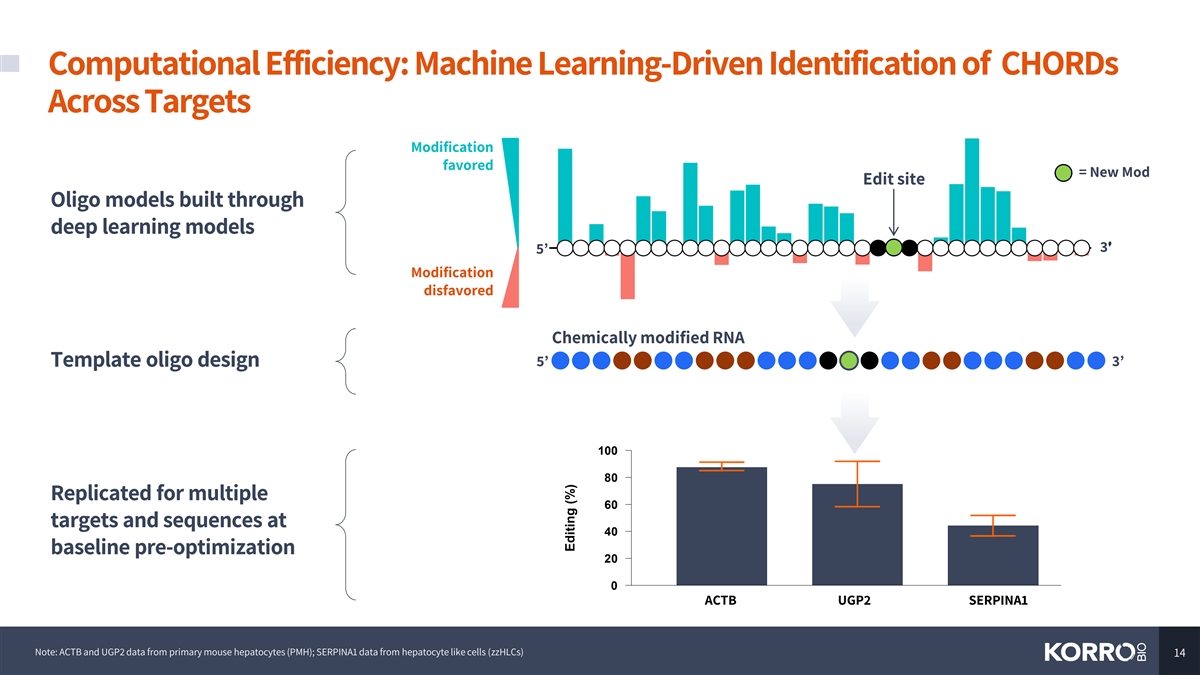
Computational Efficiency: Machine Learning-Driven Identification of
CHORDs Across Targets Modification favored = New Mod Edit site Oligo models built through deep learning models 3’ 5' 5’ 3' Modification disfavored Chemically modified RNA 5’ 3’ Template oligo design 100 80 Replicated for
multiple 60 targets and sequences at 40 baseline pre-optimization 20 0 ACTB UGP2 SERPINA1 Note: ACTB and UGP2 data from primary mouse hepatocytes (PMH); SERPINA1 data from hepatocyte like cells (zzHLCs) 14 Editing (%)
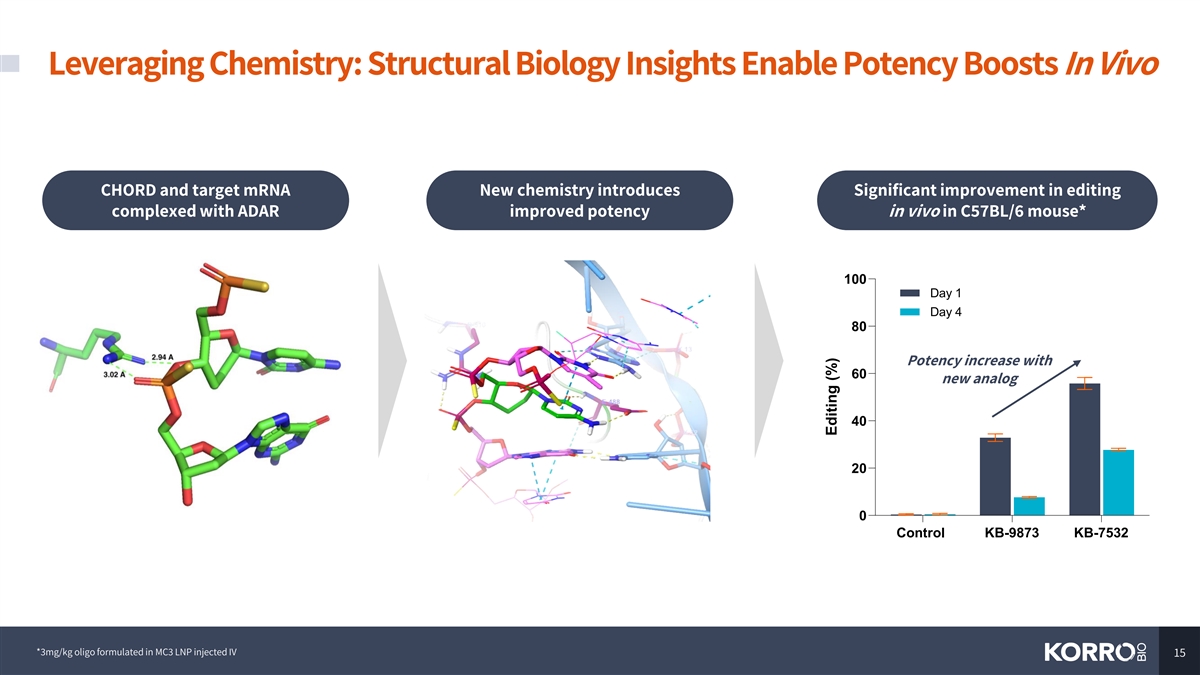
Leveraging Chemistry: Structural Biology Insights Enable Potency Boosts
In Vivo CHORD and target mRNA New chemistry introduces Significant improvement in editing complexed with ADAR improved potency in vivo in C57BL/6 mouse* 100 Day 1 Day 4 80 Potency increase with 60 new analog 40 20 0 Control KB-9873 KB-7532 *3mg/kg
oligo formulated in MC3 LNP injected IV 15 Editing (%)
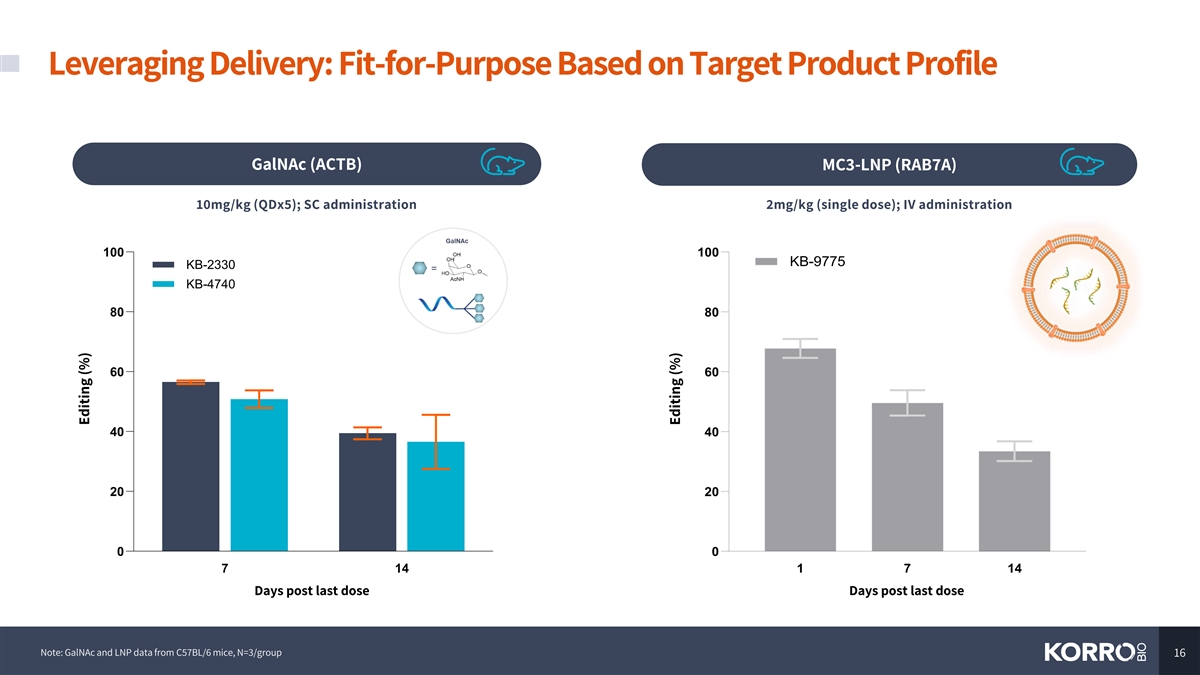
Leveraging Delivery: Fit-for-Purpose Based on Target Product Profile
GalNAc (ACTB) MC3-LNP (RAB7A) 10mg/kg (QDx5); SC administration 2mg/kg (single dose); IV administration 100 100 KB-9775 KB-2330 KB-4740 80 80 60 60 40 40 20 20 0 0 7 14 1 7 14 Days post last dose Days post last dose Note: GalNAc and LNP data from
C57BL/6 mice, N=3/group 16 Editing (%) Editing (%)
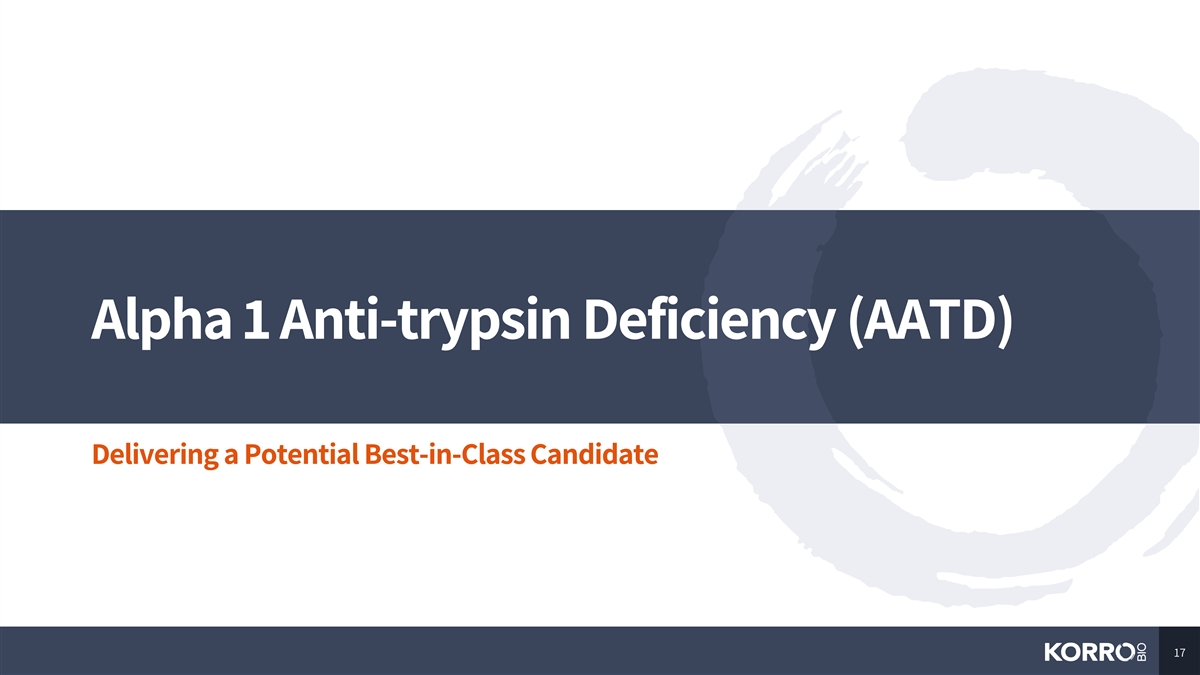
Alpha 1 Anti-trypsin Deficiency (AATD) Delivering a Potential
Best-in-Class Candidate 17
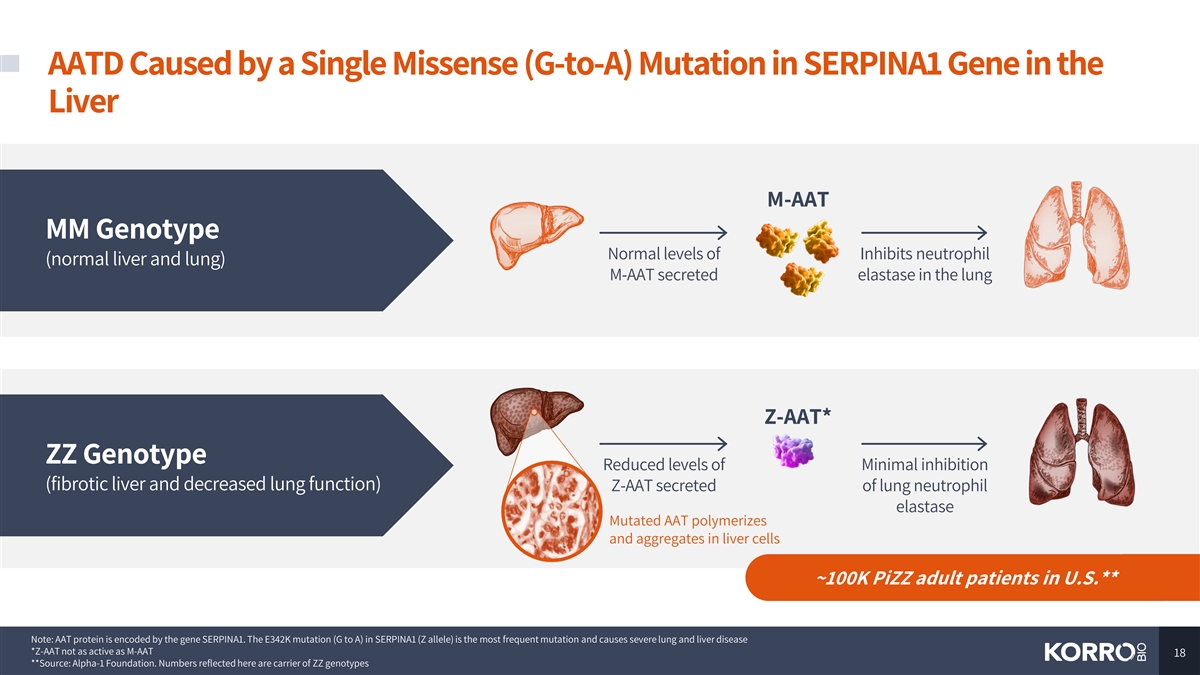
AATD Caused by a Single Missense (G-to-A) Mutation in SERPINA1 Gene in
the Liver M-AAT MM Genotype Normal levels of Inhibits neutrophil (normal liver and lung) M-AAT secreted elastase in the lung Z-AAT* ZZ Genotype Reduced levels of Minimal inhibition (fibrotic liver and decreased lung function) Z-AAT secreted of lung
neutrophil elastase Mutated AAT polymerizes and aggregates in liver cells ~100K PiZZ adult patients in U.S.** Note: AAT protein is encoded by the gene SERPINA1. The E342K mutation (G to A) in SERPINA1 (Z allele) is the most frequent mutation and
causes severe lung and liver disease *Z-AAT not as active as M-AAT 18 **Source: Alpha-1 Foundation. Numbers reflected here are carrier of ZZ genotypes
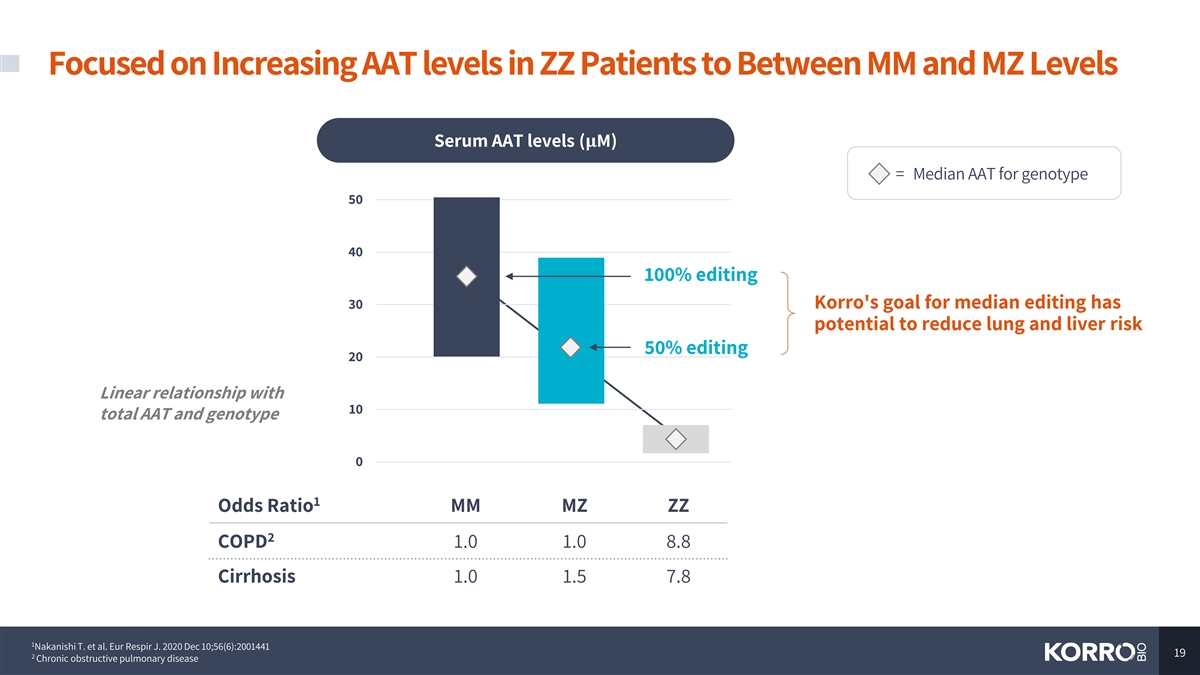
Focused on Increasing AAT levels in ZZ Patients to Between MM and MZ
Levels Serum AAT levels (μM) = Median AAT for genotype 50 40 100% editing 30 Korro's goal for median editing has potential to reduce lung and liver risk 50% editing 20 Linear relationship with 10 total AAT and genotype 0 1 Odds Ratio MM MZ ZZ 2
COPD 1.0 1.0 8.8 Cirrhosis 1.0 1.5 7.8 1 Nakanishi T. et al. Eur Respir J. 2020 Dec 10;56(6):2001441 19 2 Chronic obstructive pulmonary disease
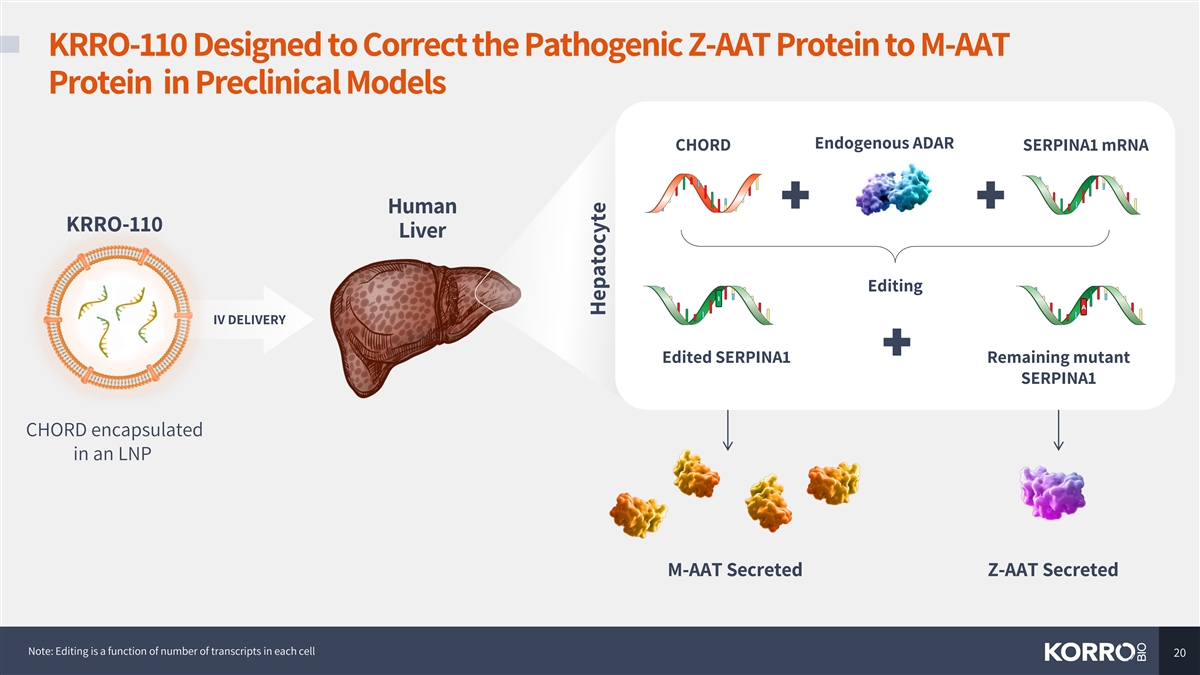
KRRO-110 Designed to Correct the Pathogenic Z-AAT Protein to M-AAT
Protein in Preclinical Models Endogenous ADAR CHORD SERPINA1 mRNA Human KRRO-110 Liver Editing I A IV DELIVERY Edited SERPINA1 Remaining mutant SERPINA1 CHORD encapsulated in an LNP M-AAT Secreted Z-AAT Secreted Note: Editing is a function of number
of transcripts in each cell 20 Hepatocyte
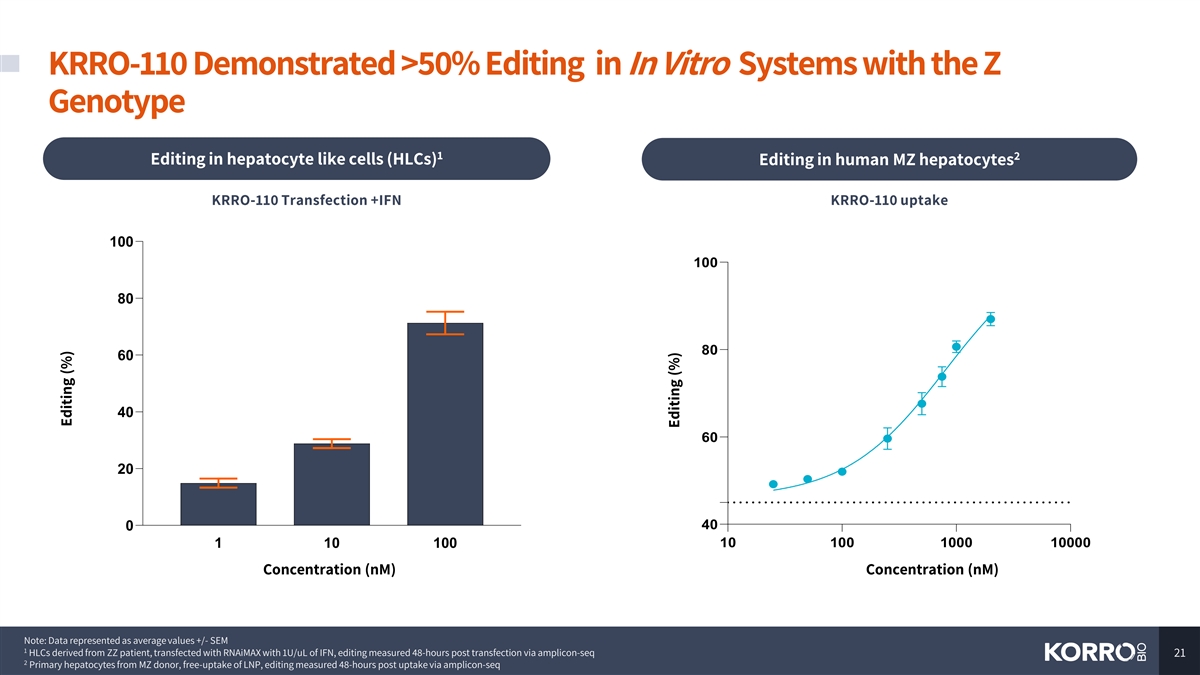
KRRO-110 Demonstrated >50% Editing in In Vitro Systems with the Z
Genotype 1 2 Editing in hepatocyte like cells (HLCs) Editing in human MZ hepatocytes KRRO-110 Transfection +IFN KRRO-110 uptake 100 100 80 80 60 40 60 20 40 0 1 10 100 10 100 1000 10000 Concentration (nM) Concentration (nM) Note: Data represented as
average values +/- SEM 1 HLCs derived from ZZ patient, transfected with RNAiMAX with 1U/uL of IFN, editing measured 48-hours post transfection via amplicon-seq 21 2 Primary hepatocytes from MZ donor, free-uptake of LNP, editing measured 48-hours
post uptake via amplicon-seq Editing (%) Editing (%)
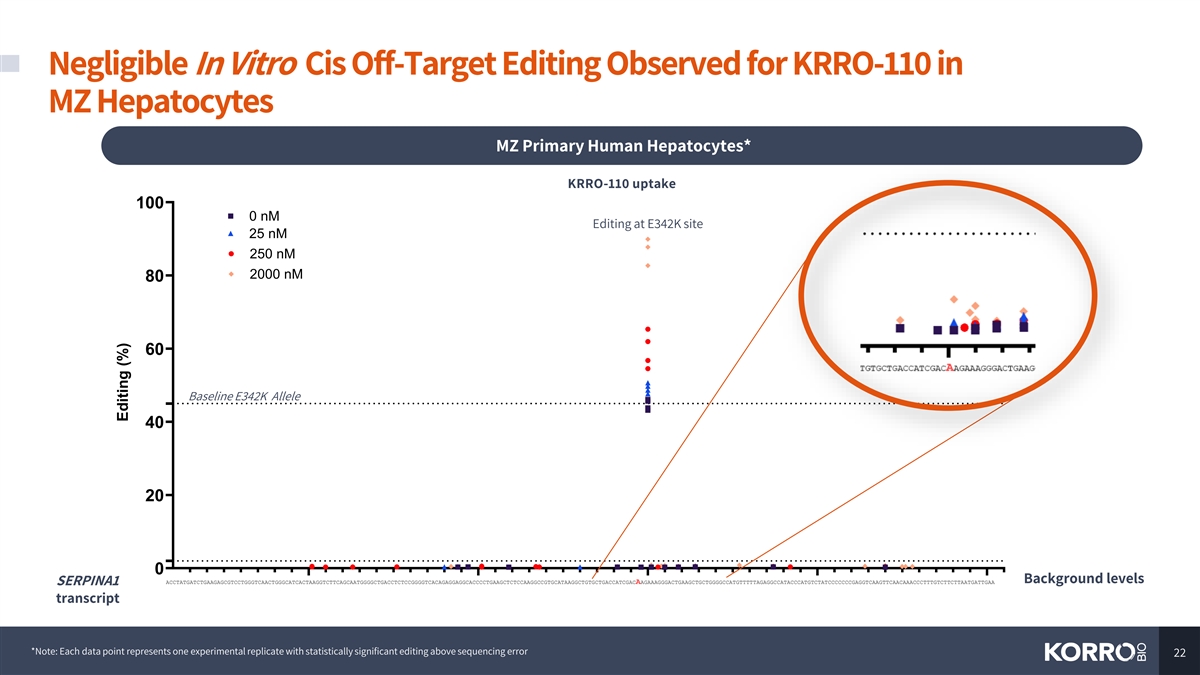
Negligible In Vitro Cis Off-Target Editing Observed for KRRO-110 in MZ
Hepatocytes MZ Primary Human Hepatocytes* KRRO-110 uptake 100 0 nM Editing at E342K site 25 nM 250 nM 2000 nM 80 60 Baseline E342K Allele 40 20 0
ACCTATGATCTGAAGAGCGTCCTGGGTCAACTGGGCATCACTAAGGTCTTCAGCAATGGGGCTGACCTCTCCGGGGTCACAGAGGAGGCACCCCTGAAGCTCTCCAAGGCCGTGCATAAGGCTGTGCTGACCATCGACAAGAAAGGGACTGAAGCTGCTGGGGCCATGTTTTTAGAGGCCATACCCATGTCTATCCCCCCCGAGGTCAAGTTCAACAAACCCTTTGTCTTCTTAATGATTGAA
Background levels SERPINA1 transcript *Note: Each data point represents one experimental replicate with statistically significant editing above sequencing error 22 Editing (%)

Achieved >50% Editing in Human Transgenic Mouse Model of Z Genotype
with a Single Dose Study design Editing in NSG-PiZ mouse KRRO-110; 2mg/kg (single dose) 100 0 1 2 3 4 5 6 7 8 9 Week 80 NSG-PiZ Week 1 Week 9 mouse Results Results 60 I.V. 40 20 0 Control Week 1 Week 9 Well-tolerated in mice toxicity studies at 5
mg/kg Note: Data represented as average values (n=3) +/- SEM 23 Similar results obtained in C57BL/6-PiZ mice licensed from Dr. Jeff Teckman Editing (%)
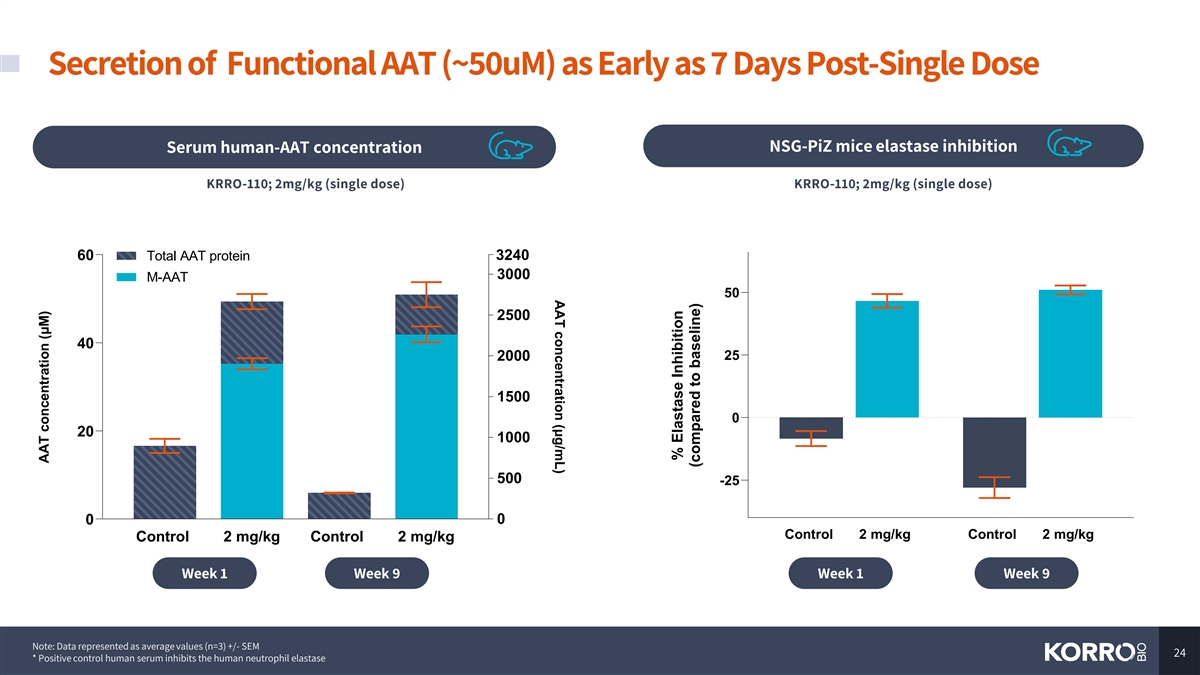
AAT concentration (μg/mL) Secretion of Functional AAT (~50uM) as
Early as 7 Days Post-Single Dose NSG-PiZ mice elastase inhibition Serum human-AAT concentration KRRO-110; 2mg/kg (single dose) KRRO-110; 2mg/kg (single dose) 60 3240 Total AAT protein 3000 M-AAT 50 2500 40 25 2000 1500 0 20 1000 500 -25 0 0 Control
2 mg/kg Control 2 mg/kg Control 2 mg/kg Control 2 mg/kg Week 1 Week 9 Week 1 Week 9 Note: Data represented as average values (n=3) +/- SEM 24 * Positive control human serum inhibits the human neutrophil elastase AAT concentration (μM) %
Elastase Inhibition (compared to baseline)

Editing De Novo Adenosine on Cyno SERPINA1 to Elucidate Editing in
Higher Species Utility in PiZ mouse E342K target site for KRRO-110 Edited (M-AAT) protein detected A >98% homology SERPINA1 transcript of human ADAR A and cyno ADAR Surrogate target site to induce Utility in PiZ mouse and in NHPs amino acid
change for KB-1494-GVT1 Edited protein detected (different construct with similar chemistry) 25

Editing at Surrogate Target Site in AATD Mouse Model Translated to
Higher Species Editing in C57BL/6-PiZ mice (%) Editing in NHPs (%) 2mg/kg (single dose) 2mg/kg (single dose) 2mg/kg (single dose) 100 100 KB-1494-GVT1 KB-1494-GVT1 80 80 60 60 40 40 20 20 0 0 Day 4 Day 14 Day 5 Day 15 Surrogate Target Site: SERPINA1
Surrogate Target Site: SERPINA1 Note: Data represented as average values +/- SEM 26 Editing (%) Editing (%)

KRRO-110 Has Potential for Best-in-Class Profile for AATD Patients
Efficacy Safety Translation to higher species ✓ Achieved AAT levels ✓ No off-target effect ✓ Ability to edit in human cells between MM and MZ in observed to date ✓ Translation to NHP with rodents as early as ✓ No
effect on endogenous surrogate oligo Week 1 ADAR activity observed ✓ Secreted functional AAT to date and inhibits neutrophil ✓ Well tolerated in non-GLP elastase safety studies (mice, NHP) ✓ Rapid reduction in Z-aggregates and
Z-AAT protein 1 Preclinical data package supports goal to submit regulatory filing in 2H 2024 and enable FIH study 1 Subject to submission of an Investigational New Drug (IND) application to the U.S. Food and Drug Administration (FDA) or similar
application with regulatory agencies in other geographies and subsequent authorization to proceed 27
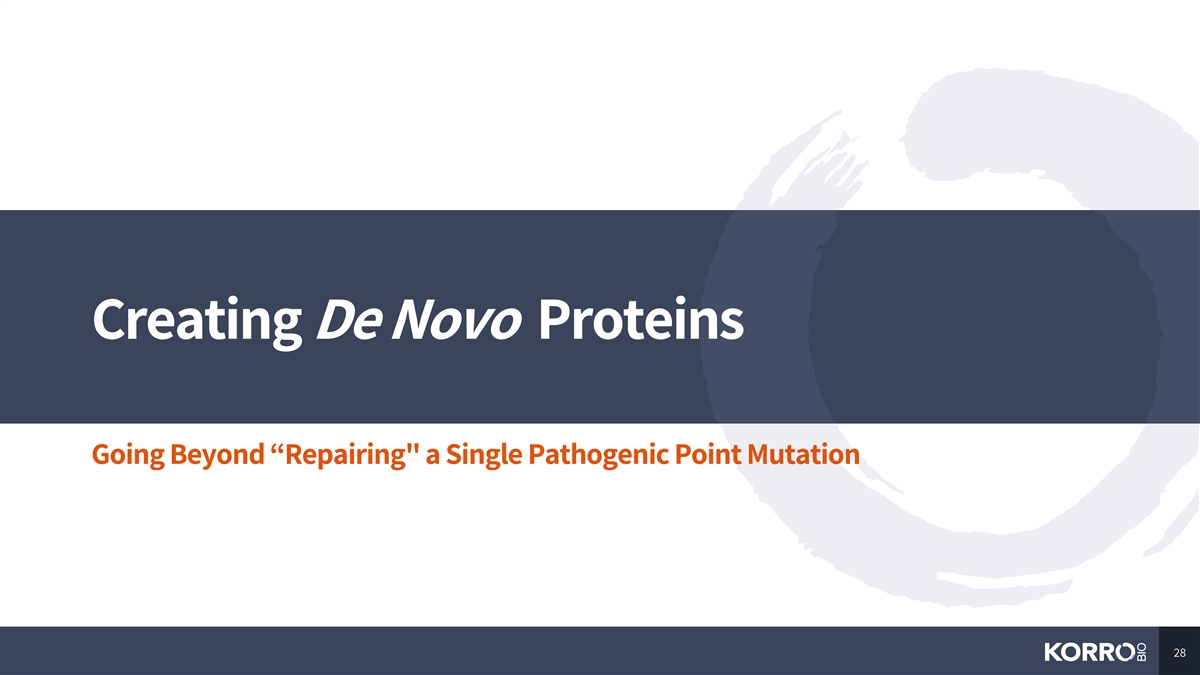
Creating De Novo Proteins Going Beyond “Repairing a Single
Pathogenic Point Mutation 28

Creating De Novo Protein Variants to Modulate Protein Function
Disrupting protein-to- Increasing protein expression / half-life protein interactions Single amino acid changes can have Preventing Disrupting aggregation of pathogenic protein a dramatic effect yet maintaining downstream function protein
aggregation on disease biology Modulating Changing electrical activity within ion channels to within physiological levels ion channels 29
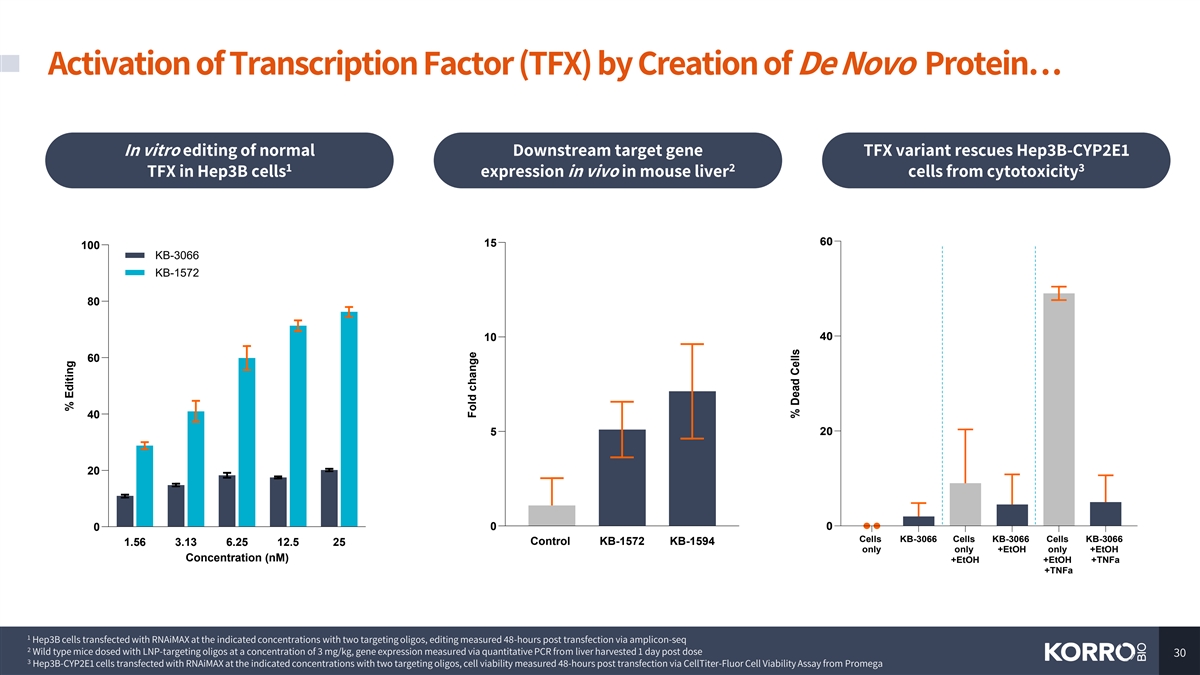
Activation of Transcription Factor (TFX) by Creation of De Novo
Protein… In vitro editing of normal Downstream target gene TFX variant rescues Hep3B-CYP2E1 1 2 3 TFX in Hep3B cells expression in vivo in mouse liver cells from cytotoxicity 60 15 100 KB-3066 KB-1572 80 40 10 60 40 20 5 20 0 0 0 Cells KB-3066
Cells KB-3066 Cells KB-3066 Control KB-1572 KB-1594 1.56 3.13 6.25 12.5 25 only only +EtOH only +EtOH Concentration (nM) +EtOH +EtOH +TNFa +TNFa 1 Hep3B cells transfected with RNAiMAX at the indicated concentrations with two targeting oligos,
editing measured 48-hours post transfection via amplicon-seq 2 Wild type mice dosed with LNP-targeting oligos at a concentration of 3 mg/kg, gene expression measured via quantitative PCR from liver harvested 1 day post dose 30 3 Hep3B-CYP2E1 cells
transfected with RNAiMAX at the indicated concentrations with two targeting oligos, cell viability measured 48-hours post transfection via CellTiter-Fluor Cell Viability Assay from Promega % Editing Fold change % Dead Cells
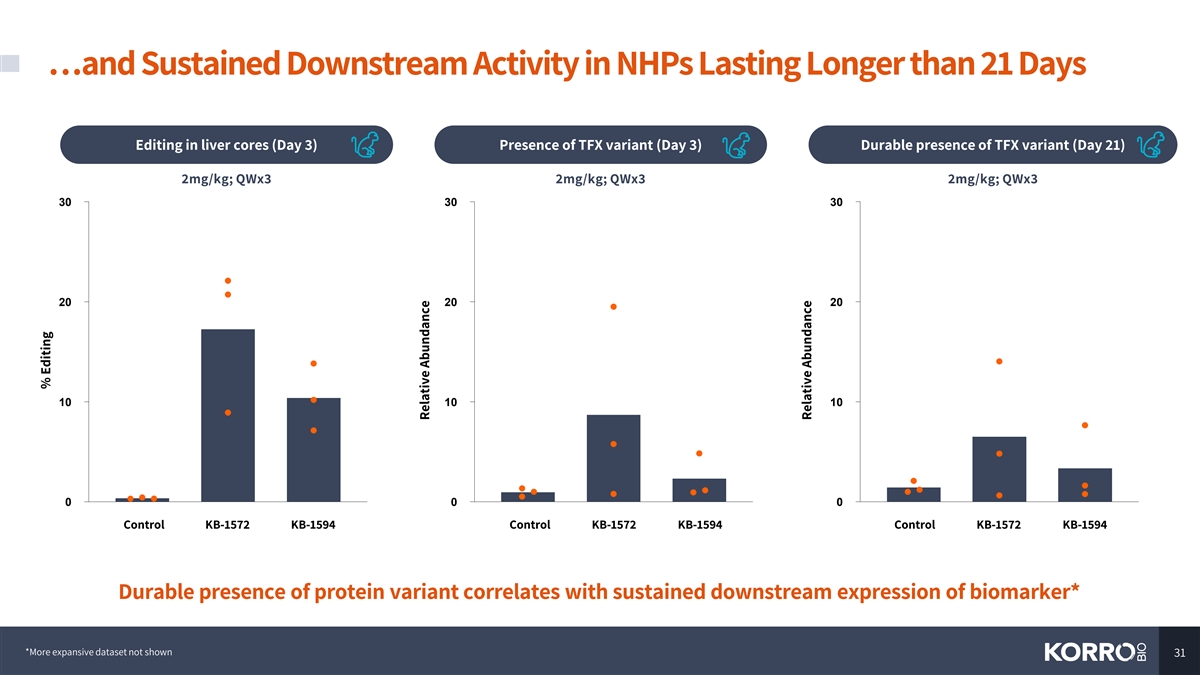
…and Sustained Downstream Activity in NHPs Lasting Longer than 21
Days Editing in liver cores (Day 3) Presence of TFX variant (Day 3) Durable presence of TFX variant (Day 21) 2mg/kg; QWx3 2mg/kg; QWx3 2mg/kg; QWx3 30 30 30 20 20 20 10 10 10 0 0 0 Control KB-1572 KB-1594 Control KB-1572 KB-1594 Control KB-1572
KB-1594 Durable presence of protein variant correlates with sustained downstream expression of biomarker* *More expansive dataset not shown 31 % Editing Relative Abundance Relative Abundance

The Team 32

Experienced Management Team with Proven Track Record Ram Aiyar, PhD
Steve Colletti, PhD Vineet Agarwal Todd Chappell Shelby Walker Stephanie Engels Venkat Krishnamurthy, PhD Chief Executive Officer Chief Scientific Officer Chief Financial Officer Chief Operating Officer SVP, General Counsel SVP, HR People SVP, Head
of Platform and Culture 33

Board of Directors with Strong Development and Management Expertise
Nessan Rachel Meyers, Ph.D. Timothy Pearson Jean-Francois Ali Behbahani, M.D. David Lucchino Ram Aiyar, Ph.D. Bermingham, Ph.D. Experienced operator in CEO, Carrick Formela, M.D. General Partner, NEA Co-founder, and President and CEO Founder and
Executive RNA medicines Therapeutics Founder ex-CEO, Frequency Chairman; Operating Partner, Atlas Venture Therapeutics Partner, Khosla Ventures 34
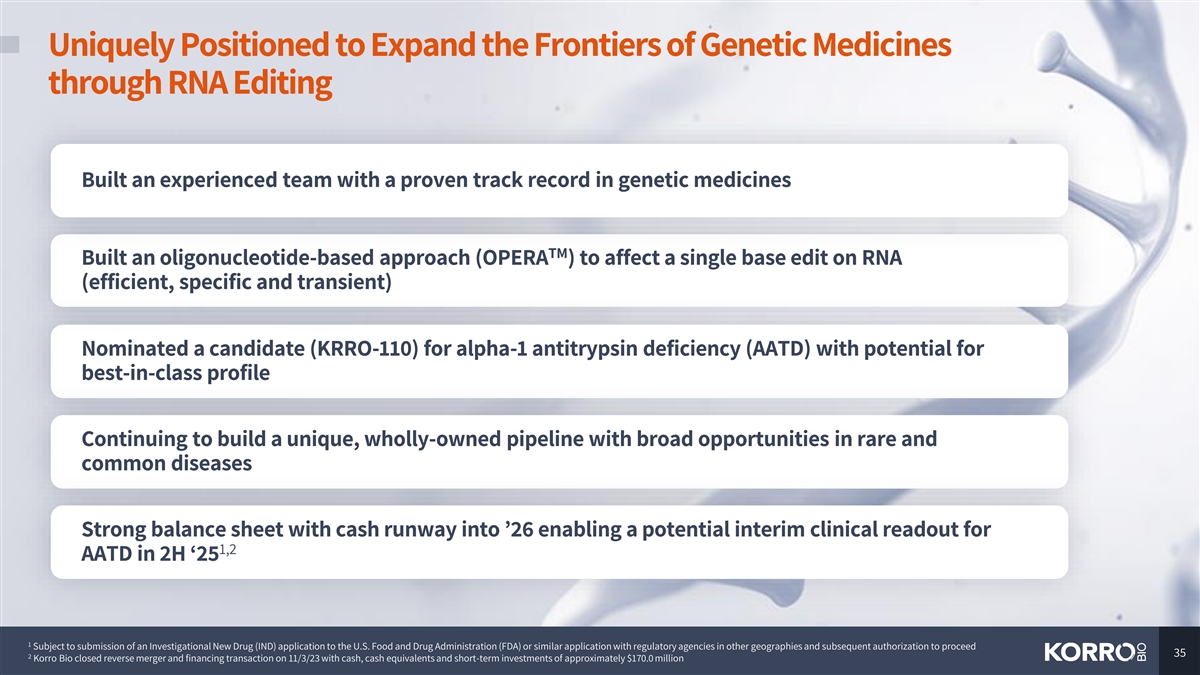
Uniquely Positioned to Expand the Frontiers of Genetic Medicines
through RNA Editing Built an experienced team with a proven track record in genetic medicines TM Built an oligonucleotide-based approach (OPERA ) to affect a single base edit on RNA (efficient, specific and transient) Nominated a candidate
(KRRO-110) for alpha-1 antitrypsin deficiency (AATD) with potential for best-in-class profile Continuing to build a unique, wholly-owned pipeline with broad opportunities in rare and common diseases Strong balance sheet with cash runway into
’26 enabling a potential interim clinical readout for 1,2 AATD in 2H ‘25 1 Subject to submission of an Investigational New Drug (IND) application to the U.S. Food and Drug Administration (FDA) or similar application with regulatory
agencies in other geographies and subsequent authorization to proceed 35 2 Korro Bio closed reverse merger and financing transaction on 11/3/23 with cash, cash equivalents and short-term investments of approximately $170.0 million

Create transformative genetic medicines for diseases with high
prevalence 36
Korro Bio (NASDAQ:KRRO)
Historical Stock Chart
From Apr 2024 to May 2024

Korro Bio (NASDAQ:KRRO)
Historical Stock Chart
From May 2023 to May 2024
